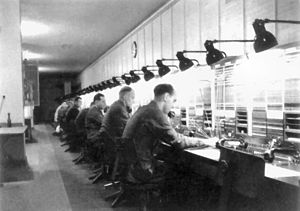
The Signal Corps or Nachrichtentruppe des Heeres, in the sense of signal troops, was an arm of service in the army of the German Wehrmacht and Waffen SS, whose role was to establish and operate military communications, especially using telephone and radio networks.
By order of the Oberkommando der Wehrmacht dated 14 Oct 1942, it was part of the combat arms of the German Wehrmacht and Waffen SS until 1945.
The colour allocated by the Wehrmacht and Waffen SS in 1935 to their signal corps was lemon yellow. By contrast, the corps colour of the air force signal troops of the Luftwaffe was brown.
During the rearming of the Wehrmacht the first top secret rearmament measures were carried out in spring 1933. These measures included the formation of new units and the establishment of a second signal company in existing units, the recruiting of officer cadets resulting in an eightfold increase over that on 1 April 1933, the reinforcing of the officer and NCO cadre by former signals soldiers, and their training through various courses.[2] From 1934, from the old signal units the required cadre of officers and soldiers was drawn for the establishment of new formations, the divisions of the Wehrmacht each receiving a signal unit. Meanwhile, the Signal Corps steadily expanded its field of expertise; they now had light, medium and heavy telephone troops, telephone exchange and telephone operating troops, telegraph construction troops, light and heavy radio troops, miniature radio troops, two-way radio troops, radio surveillance troops, patrol radio troops, cypher and evaluation troops and battery charging troops.
From 1935, the training of the Signal Corps was carried out at the Army and Air Force Signal School (Heeres- und Luftnachrichtenschule) and, from 1936, the Army Signal School (Heeresnachrichtenschule) in Halle-Dölau. Two central bunker systems were built as communication centres in Zossen and in Ohrdruf.
Overview board in the Zeppelin exchange in 1939
Exchange in the Zeppelin central signals bunker in 1942
From a special-to-arm perspective the Corps was led by the Inspector of the Signal Corps (Inspekteur der Nachrichtentruppen) at the Oberkommando des Heeres, the individual formations and units were subordinated to their respective commanders in the field army.
German Luger rifle
Georg Luger adapted his famously successful toggle lock form the Luger automatic pistol into a self-loading rifle for the German military. It was built in 8mm Mauser, but only a few prototypes were ever built.
Luger 1906 semiauto rifle in 8x57mm
According to the related patent (which you can download below, thanks to a fellow name JonMac who found if for a post on The Firearms Blog) the rifle incorporates an improvement over the Luger pistol mechanism. The pistol was known for having minimal spring pressure holding the toggle closed – a little dirt in the chamber or a bumping the cocking knobs upward could inadvertently keep the action from going fully into battery. This rifle design uses a different setup to put more positive spring pressure on the toggle when closed. This would probably not have been very easy to retrofit into the Luger pistol, simply because of space constraints.










